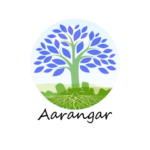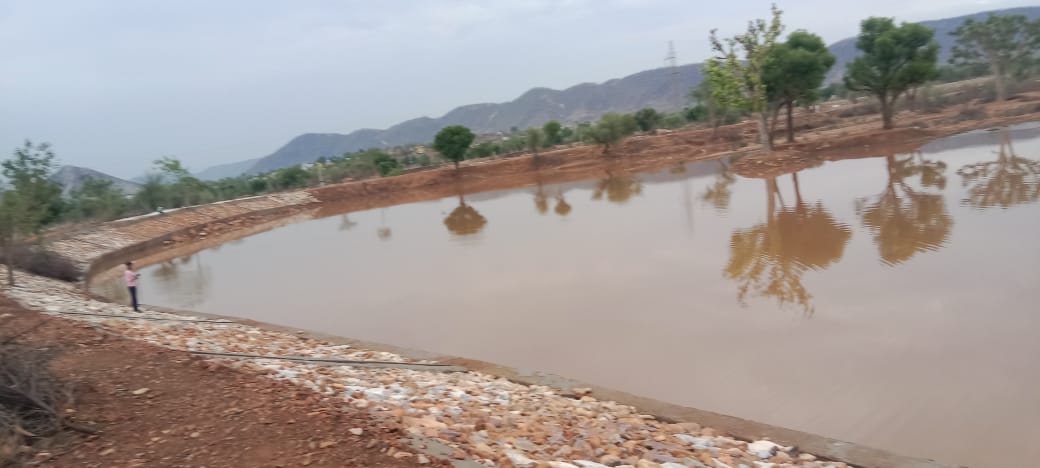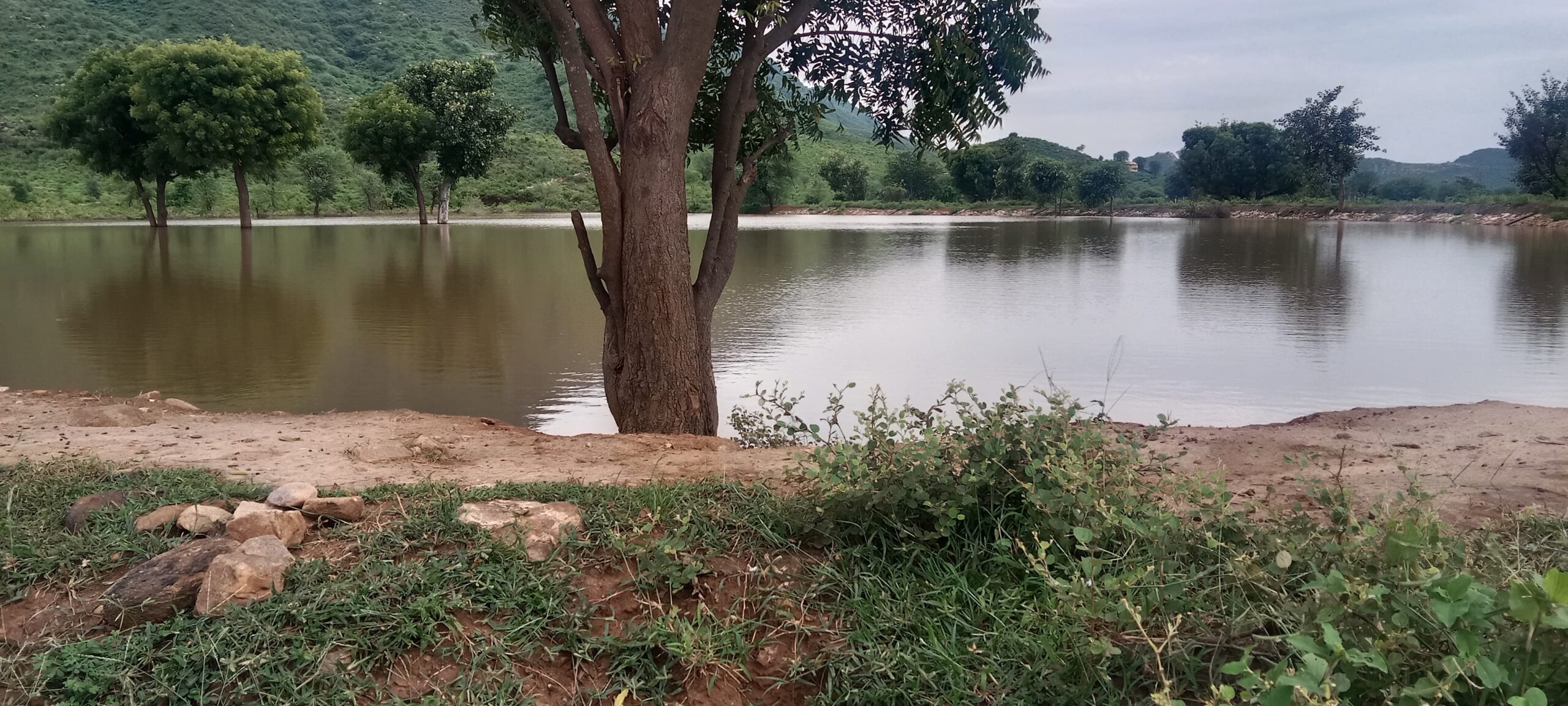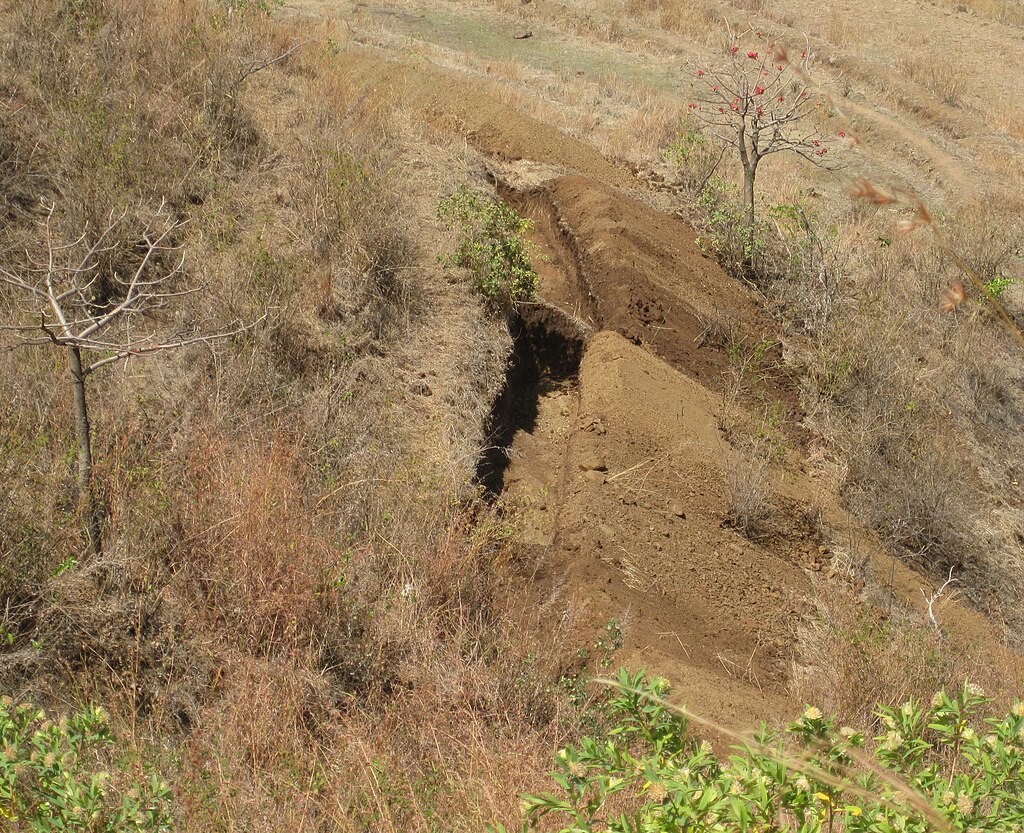On Udaipur – Sirohi highway, a right turn about 50 km from Udaipur (Rajasthan) in Gogunda Block takes you to a curvy road. Crossing a small market of Nandeshma, it is about 25 km long ride from highway to a village called ‘Teerol’. Surrounded by Aravalli hills, the landscape is undulating, hilly and rocky. During monsoons, the entire area gets covered with green grasses which turn golden, as winter approaches. Even in this cold month of January when the grasses have dried up, the landscape of Teerol looks as stunning as other villages in this part of the country. The village is inhabited by Rajput and Tribal communities, specifically Bhil.
Despite the annual average rainfall of ~637 mm, the area suffers from acute water scarcity. Wells are major source of water in the area. The sights of women and girls carrying water vessels on their heads, long queues to fill water and crowds gatherings to wash clothes at nearby water sources like piped water tap, well or a hand pump are common. And ‘Teerol’ was no different. Though the village lies on the banks of River Banas, a tributary of the Chambal River, the village faced acute water and fodder scarcity. But in the last few years, there is something that has changed in the village. The conservation of the 52 hectares of unmanaged common lands by the village community has not only charged the community positively but also made the site a spectacular place to understand the impacts of ‘Nature-Based Solutions’ for social, economical and ecological benefits.
Importance of common land: The two major sources of livelihood for rural communities – agriculture and livestock, depend extensively on the common lands for various inputs. In the Mewar region, more than half of the households in a village, on an average, depend on the common lands for a variety of products like food (leaves, fruits, tubers etc.), fodder and an array of marketable minor forest produce. The communities consume and sell these products. However, poor management of these common lands has led to their degradation, impacting the ecosystem as well as the livelihoods dependent on them.
The work to conserve the common pasture lands of ‘Teerol’ started in 2017 with setting up of a village institution – the Charagah Prabandhan evam Vikas Samiti (Pasture Land Management and Development Committee), helmed by a 14 member team including ‘a chair person, a secretary and a treasurer. Ever since, regular meetings are being held to decide the restoration work that should be taken up on priority basis in the village. The role of Megh Singh (Chairperson), Lakhma Ram (Secretary) and Jodh Singh (Treasurer) has been instrumental in the overall functioning and decision making of the committee.
According to 45 year old ‘Kheema Ram’, a Community Resource Person (CRP) and also a tribal resident of the village, the work to conserve the common lands of the village started the same year with the direct participation of the community. Initially a survey of the pasture land was carried out. The pasture land was divided into two parts to facilitate working in phases. In the first phase, about 20 hectare area was protected by building masonry stone walls and 32 hectare area was left open for grazing.
During the survey it was found that the weeds especially Lantana has covered the pasture land. Initial efforts were directed to eradicate the weeds from the closed plot. Further, android-base tools like ‘Common Land Mapping (CLM), Groundwater Monitoring Tool (GWMT) and Composite Landscape Assessment & Restoration Tool’ (CLART) and were deployed for demarcating the common lands, measuring water levels and planning of the biophysical activities in the closed plot. Information about these tools can be found at India Observatory.

To slow down the flow of runoff water, Loose Boulder Check Dams (LBCD) and bunds were built. Seeds of native grass species were sown and 12,000 saplings of indigenous plant species were planted to revegetate the pasture lands. The sapling of Madhuca Indica (Mahuwa), Boswellia serrata (Salar), Sterculia urens (Kadaya), Terminalia bellirica (Baheda), Diospyros melanoxylon (Tendu) and Wrightia tinctoria (Khirani) etc. were planted on the pastureland. The closing of a part of the pasture land for grazing helped in aiding regeneration and reducing soil erosion. However, the community was allowed to cut and carry fodder as per their need.

According to Kheema Ram ‘grasses grew in the pasture land quickly, giving benefits to us. In 2018, the work showed positive results and we could harvest grasses though production was low. From the next year onwards i.e. from 2019, the grass production has been very good”. He further added: ‘For example this year (2021 post-monsoon), 300 families of the village collected about 150 bundles of grasses. They dried this and will use it for the entire year till next monsoon, by when the grass on the pastures will regenerate and be available again. Kheema Ram, who himself owns 8 goats and a cow, further adds – “1 bundle costs about Rs 10. So, in 2021 alone, the community got fodder worth Rs. 4.5 lakh from the conserved pasture land, which improved production from livestock and helped the dependent families sustain themselves”. For many like Kheema Ram, the sale of a male goat fetches occasional additional income and is crucial. But more important is the cow milk which adds to their family’s nutritional intake. In this scenario, the availability of free-of-cost fodder from the common pasture lands is a big relief for them.
The community efforts have also resulted in increased water availability in the village. Now water remains available across the year and farmers can take Rabi (winter) crop as well. According to Kheema Ram ‘2018-19 mein LBCD ka kaam chala tha. Nalon mein bundh lagaye the. Us se pani ka bahav ruka. Gaon mein pani ki badotari hui hai. Kuon mein pani badha hai. Gehu ke season mein pani kam padta tha ab nahi padta. Pure saal pani rehta hai’ (In 2018-19, we constructed LBCDs and bunds This considerably reduced the flow of water and has resulted in increased water availability in the village. The water level in the wells has also increased. Earlier, because of less water availability, we could not grow wheat (Rabi crop) but now we are able to grow it as water is available throughout the year)”.
The community of the village is dependent more on animal rearing than agriculture. Agriculture lands holdings are small, the terrain is hilly and production is low. Kheema Ram owns 1.5 bigha land. Until recently, he would grow only one crop (Corn in Kharif season) a year. As his land is located below the pasture land, his farm is directly getting benefits of the water conservation efforts there. The soil on his farm now remains moist, even during winters. This is the first time (December 2021) that he has cultivated Gram and Mustard. At present, the crops stand tall in his farm and he is waiting for them to get matured.
This is a win-win situation as the community governed common pasture lands have not only fulfilled the fodder and water requirements of the community and supported them economically, but in comparison to unmanaged common lands, the restored pastures have also brought about innumerable climatic and ecological benefits.
There are several parameters that indicate towards the ecological and climatic benefits of community managed common lands. Common lands are natural carbon pools that store large quantities of carbon for longer periods of time. Degradation of these common lands, however, affects the potential of these lands to ‘trap carbon’ and leads to increased concentration of CO2 in the atmosphere. FES undertakes Annual Socio-Ecological Monitoring across several sites, including sites across Udaipur, to quantify the environmental benefits of the revival of degraded common lands. The results from the monitoring in 2019-20 shows that the carbon stock of the community managed common lands (12.6 tonnes/ha) is approximately 5 times higher than that of the unmanaged common lands (2.6 tonnes/ha). Similarly standing biomass of the community managed common lands (27.9 tonnes/ha) is also approximately 5 times higher that of the unmanaged common lands (5.8 tonnes/ha).
Species Diversity is another measure of an ecosystem’s richness and health. If an ecosystem has poor species diversity, it indicates an unstable ecosystem. Good species diversity contributes to communities’ livelihoods and well-being by providing food security via enhancing resilience against future risks and changing climatic conditions and supports pollination. It also helps improve the availability and quality of fresh water and regulates climate and air quality of the area. Diversity indices, including the tree species richness and Shannon’s index are important indicators to understand the condition of diversity of an area. The study mentioned above also showed that the community managed common lands have Species richness (S) 14 and Shannon’s index 2.05 as compared to Species richness (S)8 and Shannon’s index: 1.53 of unmanaged common lands. The higher species richness indicates better availability of produce like NTFP (Non-Timber Forest Produce), natural fibers and fuel-wood to the community, while plant species diversity in common lands indicates more fodder availability.
Landless, marginal and small farmers constitute more than 85% of the rural households in this area. Most of these households rear livestock and nearly 75% of them are dependent on the village common lands for fodder requirements. When the fodder available in the village falls short of the requirement, the communities have to purchase it from other sources. Lack of fodder availability further makes low-income households vulnerable, with increased costs of procuring fodder making livestock -keeping economically unviable. Livestock rearing in these locations are viable only if a significant portion of fodder and feed availability comes from the common lands. The study conducted by FES indicates that in this area, fodder availability on the community managed common lands (1.5 tonnes/ha) is 15 times higher than that of the unmanaged common lands (0.1 tonnes/ha). Improved fodder availability from common pastures means that the communities have no or little dependence on market sources for the same, making livestock rearing viable for these marginalised communities.
Restoration and conservation of degraded pasture land of Teerol is a ‘Nature Based Solution’ to address societal challenges of fodder and water, to support carbon capture by enhanced biomass production, to enrich plant biodiversity and to enhance the self-sustenance capacity of the community by enabling the cultivation of more crops in a year as well as to make livestock rearing viable.
The conservation of pastures in Teerol is an ongoing process and the communities of Teerol understand this very well. They know that continued efforts on part of the community, both for commons restoration and conservation as well as for its management are crucial. To keep on improving the health of the ecosystem, the communities continue undertaking soil and moisture conservation works like contour trenches across the hilly pasture land. The community is accessing public funds like MGNREGS, under which they have planned to create five kachha (mud) ponds and two anicuts. According to Kheema Ram ‘Anicut ka kaam chal raha hai. Do mahine pahle December mein Shuru hua. Ek ban chukka hai aur doosre par abhi kaam chal raha hai. Talai monsoon se pahle hi chalu hui thi. 2021 mein hi bani. Mitti ki hai to pahle saal pani jyada nahi ruka. Mitti ka jamav nahi hua. Aasha hai ki agle saal se pani rukega’ (The work to create anicuts started two months ago in December 2021. One anicut has been completed and the second is in progress. Talai (Pond) was created before monsoon of 2021 but it could not hold much water as it was new and the soil was loose. The mud will settle down a bit now and hopefully it will hold water as per our expectation in coming monsoons.
The continued efforts of the communities towards restoration and management of their pastures will ensure that their Commons remain healthy and productive. The efforts will continue to further slowdown the runoff of rain water, enhance its storage as well as ground water recharge and improve soil moisture to support the growth of the grasses and trees. One can see the labourers, mostly women of Teerol, working tirelessly across the pastureland. This is because the cold months of January and February till April are the best in terms of weather to carry out this kind of work. From May onwards it will be too hot to even stand outside. And who knows it better than the women of the area?
—————————
– Foundation for Ecological Security (FES) has been assisting communities in the region, including Teerol, better manage and govern their Commons since 2000. Set up in 2001, FES is a non-governmental organisation working towards the conservation of nature and natural resources – such as forests, pastures, and water resources – to enhance the economic and social well-being of rural communities across the country. These Commons, or common pool resources, form the core of rural economies and ecosystems. We enable rural communities to secure ownership rights over their Commons, restore and manage them by unlocking public investments such as MGNREGS, thereby enhancing their livelihoods and well-being. More information about FES’ work can be found at https://www.fes.org.in/.
The restoration and livelihood initiatives in Teerol village have been funded by Bajaj Auto, Axis Bank Foundation, Grow Trees and the communities have also leveraged substantial funds from MGNREGS for restoration work on their pastures under Charagah Vikas Karya.
-The ‘Annual Socio-Ecological Monitoring, finding of which from 2019-20 are mentioned in the article, is carried out by FES annually to quantify the environmental benefits of the restoration of degraded common lands. The monitoring is carried out in 150 sites across seven states annually to build evidence in support of community’s management and restoration of Commons.







Leave a Reply